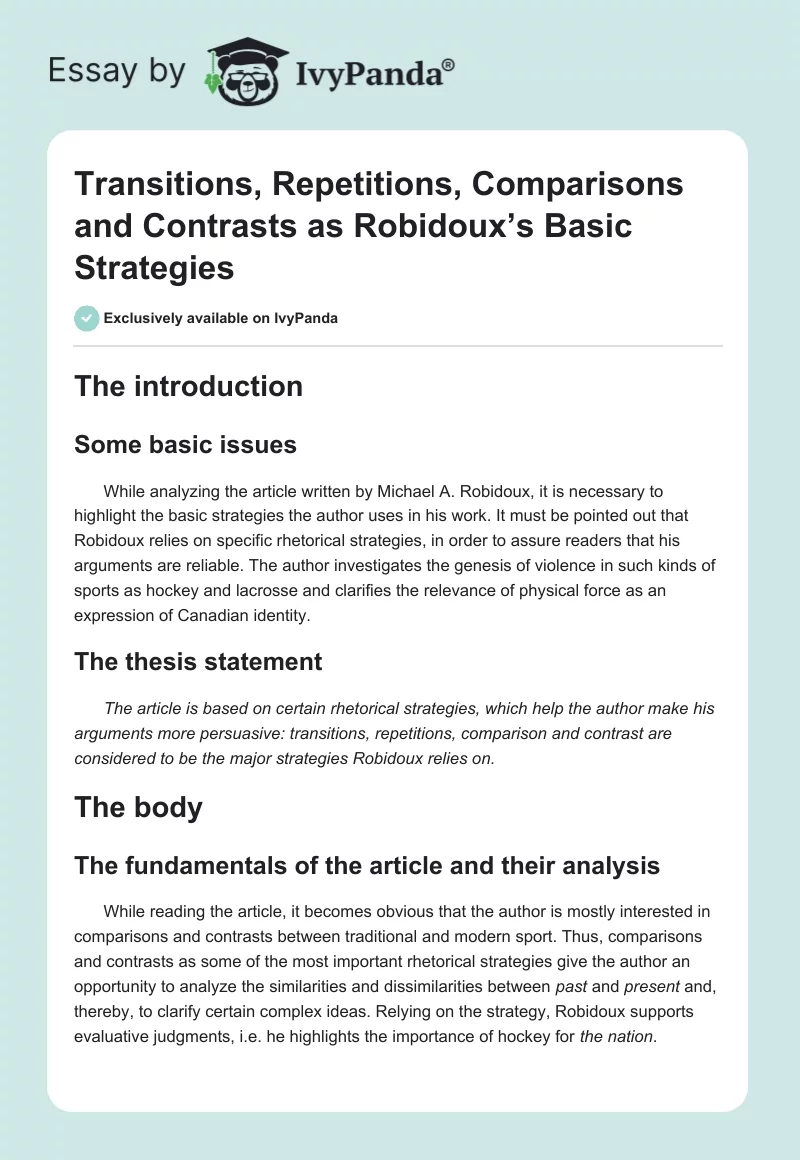The introduction
Some basic issues
While analyzing the article written by Michael A. Robidoux, it is necessary to highlight the basic strategies the author uses in his work. It must be pointed out that Robidoux relies on specific rhetorical strategies, in order to assure readers that his arguments are reliable. The author investigates the genesis of violence in such kinds of sports as hockey and lacrosse and clarifies the relevance of physical force as an expression of Canadian identity.
The thesis statement
The article is based on certain rhetorical strategies, which help the author make his arguments more persuasive: transitions, repetitions, comparison and contrast are considered to be the major strategies Robidoux relies on.
The body
The fundamentals of the article and their analysis
While reading the article, it becomes obvious that the author is mostly interested in comparisons and contrasts between traditional and modern sport. Thus, comparisons and contrasts as some of the most important rhetorical strategies give the author an opportunity to analyze the similarities and dissimilarities between past and present and, thereby, to clarify certain complex ideas. Relying on the strategy, Robidoux supports evaluative judgments, i.e. he highlights the importance of hockey for the nation.
In other words, the author reveals the history of sport development in Canada, in order to represent the idea of nationalism. In my opinion, the primary task the author wanted to achieve was not only to reflect the interdependence between sport and identity, but to reinforce the kind of interdependence, i.e. he wanted to show that “to be a nation who plays hockey, means to understand what it means to be Canadian as being raced (namely white), classed (namely middle-class), gendered (namely boys and men), and sexualized (namely straight) in very particular ways” (Allain 8).
At first sight, it seems that Robidoux gives the readers an opportunity to trace back important historical events and make a corresponding conclusion. However, the author develops his arguments in a specific manner. When analyzing the article deeper, one can notice that the author’s every conclusion boils down to a question of Canadian national identity as distinct from Britain and America.
Thus, the author points out that “the question becomes, then, how did a game such as hockey not only take shape in Canada, but become frequently cited as evidence that a Canadian culture exists” (Robidoux 209). When analyzing the sentence, it becomes obvious that the author uses transitions, in order to make a conclusion on the existence of Canadian identity.
Robidoux tries to convince his readers in certain arguments by adding another points (furthermore), indicating cause and effect (then), emphasizing the importance of final results (in order to respond to…), etc.
As far as the author’s every conclusion is related to the issue of Canadian nationalism, one can conclude that Robidoux tries to intensify the importance of Canadian identity through repetitions. He speaks about Canadian uniqueness all over. For this reason, the author’s arguments seem to be mostly subjective. That means that Robidoux’s arguments possess both strengths and weaknesses.
One can suggest that my opinion is wrong, because the author recognizes certain contradictions in relation to the topic. For instance, Robidoux states:
Since World War II, Canadians have been internationally perceived more as
peacekeepers and, perhaps, even as being unreasonably polite – both
political constructions in themselves – which makes it difficult to comprehend
why a game such as hockey, known for its ferocity, speed and violence,
would come to serve as Canada’s primary national symbol” (Robidoux 209).
To qualify a point again, the author uses transition (perhaps); comparisons and contrasts (thus, hockey as a violent sport and polite Canadians are considered to be incompatible issues), repetitions (while pointing out Canadian national symbol). While speaking about the strengths of the article, one is to keep in mind that the author’s analysis is based on strong evidence. He uses various kinds of sources and provides us with opinions of other researchers, specialists, critics, etc.
The author pointed out that hockey and lacrosse played a great role in establishing Canada as a separated nation. He discovered the impact of sport on Canada’s national mythology appearance. To my mind, the author wanted to represent the country as a peaceful nation, and it is obvious that he succeeded in the kind of representation. On the other hand, however, it seems that some important aspects were neglected.
I suppose that his article lacks some important details. Although, Robidoux showed us the relationship between the kinds of sport and Canadian identity, he failed to explain some specific points concerning Canada’s fear of American cultural imperialism. In my opinion, the author had to draw particular attention to Canada’s geographical proximity to America; while he mostly considered the impact of certain historical events on Canada’s identity formation.
The conclusion
Finally, it must be noted that the author’s arguments were effectively developed due to the rhetorical strategies he relied on; however, as far as Robidoux failed in objective reasoning, one can conclude that his persuasive techniques should be somewhat upgraded.
Comparisons and contrasts gave the author an opportunity to present cause and effect relations concerning sport and Canadian identity. Repetitions were used to intensify the meaning of certain judgments, including the issue of Canadian nationalism. Transitions were used to clarify complex, but important ideas.
Works Cited:
Allain, Kristi. Kid Crosby or Golden Boy: Sidney Crosby, Canadian National Identity, and the Policing of Hockey Masculinity, 2011. Web.
Robidoux, Michael. “Imagining a Canadian Identity Through Sport: A Historical Interpretation of Lacrosse and Hockey.” Journal of American Folklore 115(456) (2002): 209–225. Print.


